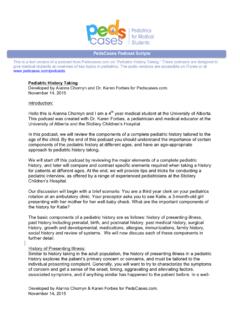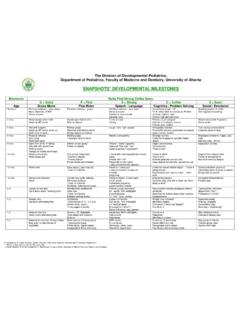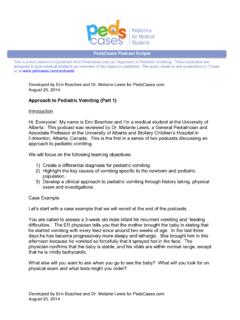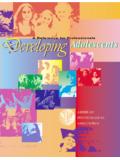Transcription of PedsCases Podcast Scripts - Pediatric Education Online
1 PedsCases Podcast Scripts This is a text version of a Podcast from on Approach to Pediatric Periorbital Edema. These podcasts are designed to give medical students an overview of key topics in pediatrics. The audio versions are accessible on iTunes or at Approach to Pediatric Periorbital Edema Developed by Monique Jarrett, Dr. Melanie Lewis, and Dr. Catherine Morgan for Jul 13, 2017. Introduction: Hello, my name is Monique Jarrett. I am a second year medical student at the University of Alberta. This Podcast was developed with the help of Dr.
2 Melanie Lewis a Pediatrician and Professor at the University of Alberta and Dr. Catherine Morgan a Pediatric Nephrologist and Associate Professor at the University of Alberta. This Podcast will help you develop an approach to a child presenting with periorbital edema. Objectives Determine the key differential diagnoses for the presentation of periorbital edema Identify historical aspects, physical exam findings and diagnostic studies that can help determine the etiology of the periorbital edema Discuss the key points on history and physical exam that differentiate periorbital cellulitis from orbital cellulitis Outline the management of periorbital cellulitis and orbital cellulitis Cases Case 1.
3 A 5-year old boy presents with rapid onset bilateral eye swelling. He has had no changes in the quality of his vision. His history includes a recent upper respiratory tract infection 2 weeks ago. Case 2: A 13-year-old boy presents to the emergency department with his left eye swollen shut. He came in straight from his baseball tournament. Upon examination, there were no changes in the quality of his vision. Developed by Monique Jarrett, Dr. Melanie Lewis, and Dr. Catherine Morgan for July 13, 2017.
4 Case 3: A 10-month old boy comes in to the emergency department with swelling and redness in his right eye. His eyelid is tender to the touch, droopy and he has a fever of 39 C. Introduction Pediatric edema or swelling can come in many forms and in various locations around the body. It also can have a variety of causes. In this Podcast , we will focus on periorbital edema. Anatomically, the orbital septum is a thin membrane separating the superficial eyelid from the deeper orbital structures. Any structure anterior to the septum is in the periorbital region and any structure posterior to the septum is in the orbital region.
5 There are 3 common scenarios that will be discussed in this Podcast : nephrotic syndrome, insect bite and periorbital cellulitis. Classifying Pediatric Periorbital Edema Classifying the edema in a child who presents with periorbital edema is an important initial step. First, you need to determine if the child has bilateral or unilateral edema. If the edema is bilateral and there are systemic symptoms of volume overload you need to start the workup up for nephrotic syndrome. The most common type of nephrotic syndrome in children is Minimal Change Disease.
6 If the edema is bilateral and there are no other major systemic features (for example, edema in the feet, ankles and abdomen), then you need to start thinking about an allergic reaction, possibly allergic conjunctivitis. This can be confirmed during history . If the swelling is unilateral and there is no fever, you need start thinking about an insect bite or eye trauma. If the edema is unilateral and the child is presenting with a fever, you need to start the workup for periorbital or orbital cellulitis.
7 Periorbital cellulitis is a bacterial infection of the eyelid and surrounding soft tissues. It occurs most often in children under 5 years old. history , physical and Diagnostic Studies Nephrotic Syndrome The most common nephrotic syndrome in children is Minimal Change Disease (MCD). If the diagnosis is nephrotic syndrome, we would expect the child to present with sudden- onset periorbital edema and the onset may follow an upper respiratory tract infection. This is very important. Many children are misdiagnosed with an allergic reaction with their first presentation of nephrotic syndrome resulting in a significant delay in treatment.
8 On examination, there will be gravity-dependent edema in the lower limbs as well. Urinalysis, urine protein-creatinine ratio (PCR), serum chemical analysis and a cholesterol lipid panel are all investigations needed to confirm the diagnosis. The child will have nephrotic range proteinuria (>50mg/kg/d or PCR >200mg/mmol). hypoalbuminemia and hyperlipidemia. Hematuria is not common in cases of MCD. Developed by Monique Jarrett, Dr. Melanie Lewis, and Dr. Catherine Morgan for July 13, 2017. Children do not need a 24-hour urine collection in order to make a diagnosis.
9 This collection is often inaccurate, therefore PCR is considered the better test. A few other investigations need to be done to ensure the NS is not due to systemic disease. Complement (C3 and C4) as well as screening labs for lupus should be done. The child should have no other signs of systemic disease. Insect Bite or Eye Trauma If the diagnosis is an insect bite or eye trauma, we would expect that the history provided by the patient should be able to confirm the diagnosis. We would expect the physical examination to be normal other than the unilateral periorbital swelling.
10 Specifically, if this is an insect bite, the area of erythema should not be painful rather the child will likely complain of itchiness to the affected area. If the area is painful you should consider cellulitis and trauma in your differential diagnosis. Clinical diagnosis can usually be made without investigations. Periorbital Cellulitis Children with periorbital cellulitis usually present unilaterally with erythema, rapid-onset swelling, ptosis (drooping eyelid), warmth and tenderness of the affected eyelid.





